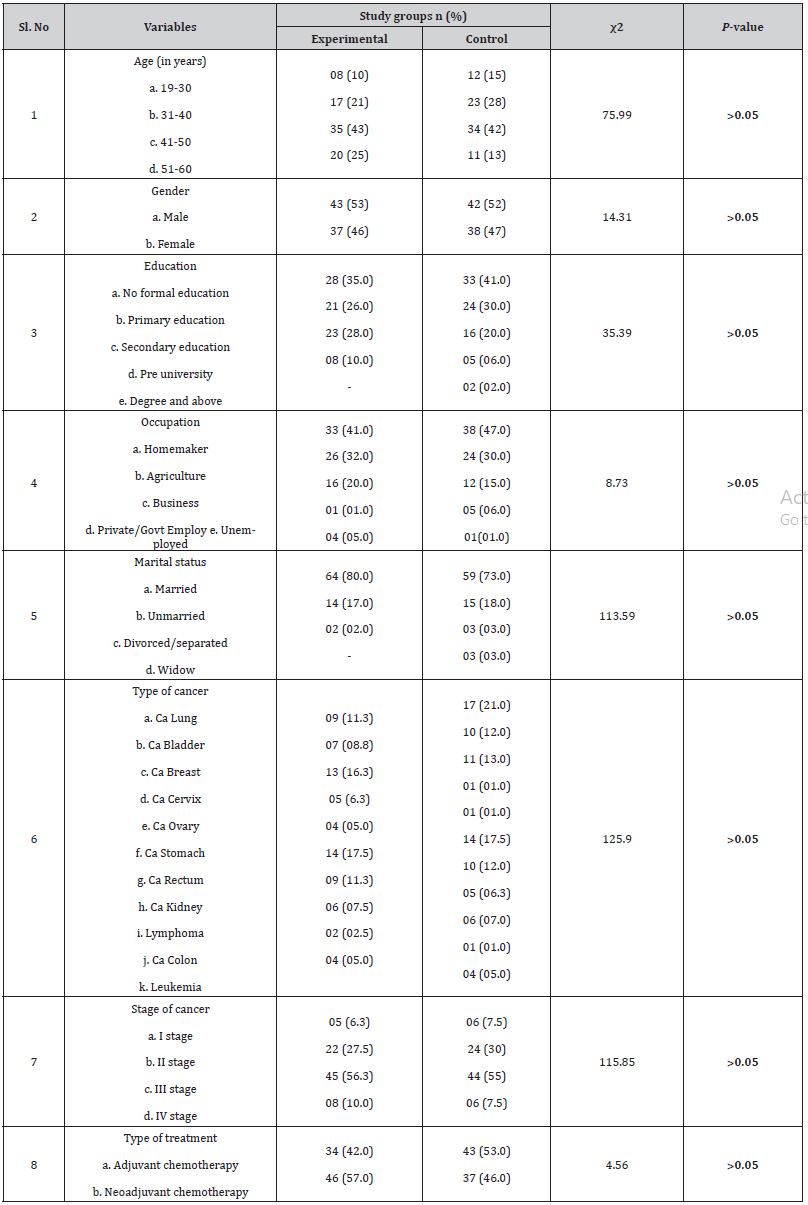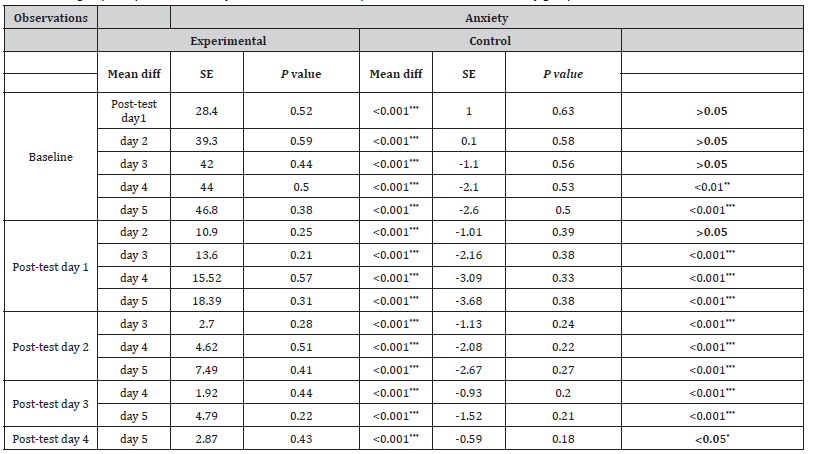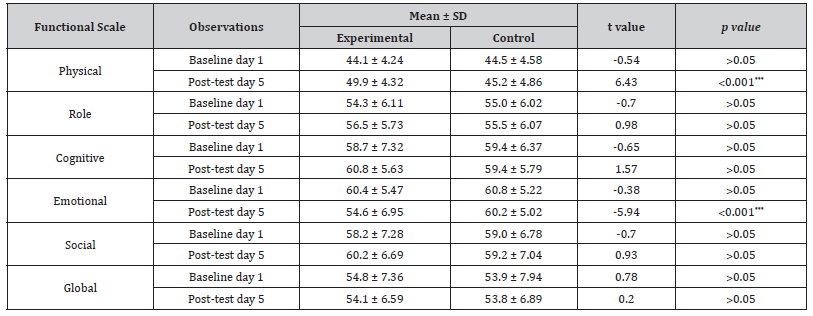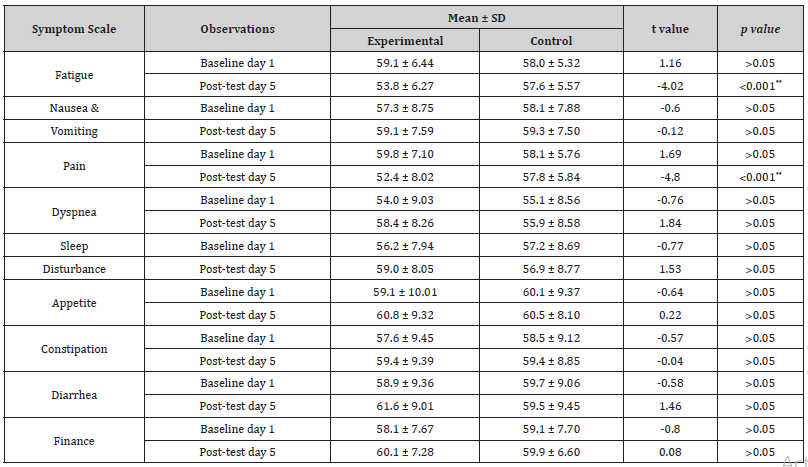 Research Article
Research Article
Effectiveness of Music Therapy on Anxiety and Quality of Life in Patients Undergoing Chemotherapy
Syed Imran1*, Moosabba MS2 and Alphonsa Ancheril3
1Department of Nursing, Batterjee Medical College, Saudi Arabia
2Department of Surgery, Yenepoya University, India
3Department of Psychiatric Nursing, Athena College of Nursing, India
Syed Imran, PhD (N), Department of Nursing, Batterjee Medical College, Saudi Arabia.
Received Date:August 8, 2022; Published Date:September 29, 2022
Abstract
Chemotherapy is the most stress-producing among all available treatment modalities. Nurses looking after the clients undergoing chemotherapy need to help them by providing non-pharmacological interventions like music which is proven to be effective among all complementary therapies.
Aim: To find the effectiveness of music on level of anxiety and to determine its effect in improving quality of life in patients with cancer undergoing chemotherapy
Settings and design: The study was conducted in the medical oncology units of two hospitals. This was quantitative research with quasi experimental nonrandomized control group design.
Methods and material:Study participants (n=160) were assigned to an intervention (n=80), and control group (n=80), by following purposive sampling technique. Anxiety and quality of life was measured using state anxiety inventory and QLQ-C30 questionnaire. The patient preferred music was administered for 3 hours during chemotherapy in the intervention group, and the control group received routine care.
Results:The results showed a significant difference in anxiety level before and after music in intervention group (p<0.05). A significant change in the quality of life was noticed from day 1 to day 5 in the intervention group. Repeated measure ANOVA showed a significant difference (p<0.05) in anxiety and quality of life at different time points in the intervention group.
Conclusion: Music had a positive effect on anxiety and quality of life in patients undergoing chemotherapy.
Keywords:Music therapy; Anxiety; Quality of life; Chemotherapy
Introduction
The cancer is taken into account to be the leading causes of universal mortality. The total number of recently diagnosed cancer may reach to twelve lakh in upcoming decades. Seventy percent recently diagnosed with cancer, and death due to this disease can be commonly seen in countries like Asia, Africa, Central, and South America [1]. The current Indian population is approximately 1.4 billion, and the incidence of cancer in India is 70-90 per 1 lakh population. The Indian Council of Medical Research (ICMR) highlights that, in males, the most common cancer is of mouth, pharynx, oesophagus, stomach, lung or bronchi while as in females, the common cancers are cervix, breast, mouth, oropharynx, and esophagus [2]. Chemotherapy is considered to be the most stress- inducing treatment amongst all other options available for cancer treatment primarily as a result of the countless side effects that the patient has to endure [3]. The chemotherapy-induced side effects are numerous which causes psychological issues in patients, such as body image disturbance and anxiety. The major side effects include alopecia, nausea, vomiting, body image disturbance, and depression. Along with the administration of medications, nurses have employed several independent nursing interventions, including relaxation training, distraction, and guided imagery, and listening to music. Nursing interventions to manage this debilitating side effect can help to reduce anxiety and greatly improve the quality of life for the patient [4].
The music therapy means the use of sound to help express hidden feelings and to improve the emotional, as well as physical wellbeing. The reason behind the use of music by patients with cancer is because, it makes them feel better. Listening to music can be calming and relaxing. Music therapy can be a safe complementary therapy to explore fear, anxiety, anger, and the range of emotional responses in patients living with cancer [5]. A recently published meta-analysis summarized the eight nonpharmacological intervention studies including three studies that are conducted with music therapy. The results showed that there was an improvement in the level of anxiety, depression, quality of life, coping, stress, anger, and mood [6]. Another systematic review analyzed the thirty quasi-randomized and randomized clinical trial researches where, 1891 patients were participated. The findings of these studies reported positive benefits of music on psychological variables such as anxiety, mood, and quality of life and physiological variables such as pulse, respiratory rate, and blood pressure in patient suffering from cancer [7]. Therefore, this study aim was to make the patients with cancer feel comfortable and to improve their overall QOL to some extent in terms of physiological (BP, heart rate, pain and body temperature), and psychological (anxiety and quality of life) parameters by providing music during chemotherapy.
Material And Methods/Experimental Details/ Methodology
Quasi experimental repeated measure nonrandomized control group design was used to conduct the study. The approval for conducting the study was obtained from the Ethics committee of Yenepoya (Deemed to be University). The study was registered in Clinical Trial Registry- India, and the registration number is CTRI/2017/09/009919. The study participants meeting the inclusion criteria were approached by the researcher and explained the purpose, benefits, and risks of the study. The participants were assured of privacy and confidentiality and asked to sign the consent form. They were given the option of withdrawal from the study, at any time with no change in their relationship with the institution.
Patients with all types and all stages of cancer were included between the age group of 19-65. Oncology units of two different hospitals were selected as one for experimental group and another for control group. Patients who were 18 years of age or older, who did not have hearing deficiencies and the chemotherapy infusion lasts for a minimum of 3 hours duration was the inclusion criteria whereas patients who were unable to listen to music due to hearing problems, who had head and neck cancer and had diabetes, hypertension, and thyroid problems were excluded from the study. All patients were provided informed consent and were informed that they could withdraw from the study at any time.
The music intervention included 10 different variety of instrumental music library. Each library had slow, instrumental music collections of 3 hours length which was recorded and stored in Sony portable mp3 players. They were selected by the investigator in consultation with music therapist as research demonstrates them to be more relaxing. The selected music libraries were sent for the validation to the experts in the field of music.
The study participants first selected one of the 10 libraries by listening to it, and then they were given with Sony portable mp3 player with 3.5mm port. The study participants were also provided with “sleep tune musical pillow” developed by Reliance comforts which had two mini electronic speakers embedded in the pillow connected through a wire with 3.5mm jack. The benefit of using a pillow in this study was to make study participants feel comfortable and to avoid keeping headphones for a long time in the ears which is uncomfortable while undergoing chemotherapy. The pillow covers were changeable and washable for infection control. The period of unsupervised activity consisted of any activity that the patient desired. The baseline assessment of anxiety and quality of life was done on day 1 before starting the chemotherapy. Music was administered to the experimental group by following the protocol for 3 hours of duration. The post-tests were done on day 1 i.e., soon after the intervention for the experimental group and after three hours of chemotherapy for the control group. Post-tests were also done on, day 2, day 3, day 4, and day 5 for both the groups.
Results
A total of 160 patients were included in the study. 80 were in intervention and 80 were in control group. The baseline and clinical characteristics of the patients are presented in table 1. No differences were found between the groups in their baseline characteristics (Tables 1 to 7).
Table 1:Baseline and clinical characteristics of study groups (N=80+80).

Note: The data of both the groups are expressed as frequency with percentage in parenthesis. Experimental group-patients with cancer receiving music intervention while undergoing chemotherapy; control group- patients with cancer receiving normal routine care while undergoing chemotherapy, Ca-Cancer. Statistical test used – Chi-square test; Level of significance – P<0.05 was consider significant, P˃0.05- non-significant.
Table 2:Comparison of anxiety level between the study groups.

Note: Study groups: Experimental – patients with cancer who were given music intervention during the chemotherapy; Control – patients with cancer received conventional care during chemotherapy. The Spielberg state anxiety inventory was used to measure the anxiety level (score range of the tool is 20-80). The statistical test used: independent t-test. Level of significance: p<0.05 *significant p˂0.05, **highly significant p˂0.01, ***very highly significant p˂0.001, p>0.05 – non significant
Table 3:Comparison of anxiety scores at different time points of observation within the study groups.

Note: Study groups: Experimental – patients with cancer who were given music intervention during the chemotherapy; Control – patients with cancer received conventional care during chemotherapy. The Spielberg state anxiety inventory was used to measure the anxiety level (score range of the tool is 20-80). The statistical test used: repeated measure ANOVA; level of significance: *significant p˂0.05, **highly significant p˂0.01, ***very highly significant p˂0.001, p>0.05 – non significant.
Table 4:Intragroup comparison of anxiety scores at different time points of observation in the study groups.

Note: The Spielberg state anxiety inventory was used to measure the anxiety level (score range of the t tool is 20-80). The statistical test used: repeated measure ANOVA; level of significance: *significant p˂0.05, **highly significant p˂0.01, ***very highly significant p˂0.001, p>0.05 – nonsignificant.
Table 5:Comparison of overall quality of life between the study groups.

Note: Study groups: Experimental – patients with cancer who were given music intervention during the chemotherapy; Control – patients with cancer received conventional care during chemotherapy. EORTC QLQ-C30 (European organization for research and treatment of cancer quality of life questionnaire) was used to measure the quality of life. The score of the scale ranges from 0-100. The statistical test used: independent t-test. level of significance: p<0.05 *significant p˂0.05, **highly significant p˂0.01, ***very highly significant p˂0.001, p>0.05- nonsignificant.
Table 6:Area wise comparison of functional domains of quality of life.

Note: Study groups: Experimental – patients with cancer who were given music intervention during the chemotherapy; Control – patients with cancer received conventional care during chemotherapy. EORTC QLQ-C30 (European organization for research and treatment of cancer quality of life questionnaire) was used to measure the quality of life. The score of the scale ranges from 0-100. The statistical test used: independent t-test. Level of significance: p<0.05 *significant p˂0.05, **highly significant p˂0.01, ***very highly significant p˂0.001, p>0.05- nonsignificant
Table 7:Area wise comparison of symptom domains of quality of life.

Note: Study groups: Experimental – patients with music intervention; Control – patients with conventional care. EORTC QLQ-C30 was used to measure the quality of life. The statistical test used: independent t-test. Level of significance: p<0.05 *significant p˂0.05, **highly significant p˂0.01, ***very highly significant p˂0.001, p>0.05- nonsignificant.
Discussion
In the present study, a significant difference (p<0.001) was observed in the anxiety level of patients undergoing chemotherapy before and after the music intervention in experimental group compared to the control group. Spielberger’s state anxiety inventory was used in the present study to assess the anxiety level. Intragroup comparison of anxiety at different time points of observation showed a significant difference (p<0.001) in experimental group from baseline to day 5 compared to the control group. Similar findings were observed in a study by Carolyn and Susan and Andreas et al. [8,9], where, the effect of music on anxiety had a significant difference (p<0.01) before and after the music intervention in the experimental group compared to the control group.
The studies by done by Ma and Jin et al. [10,11], reported, the level of anxiety was significantly (p<0.001) reduced after music intervention in the experimental group compared to the control group. Comparable findings were reported in a study by Kiley [12], showed, music intervention had a significant difference (p<0.05) on anxiety level of patients undergoing chemotherapy in experimental group.
Comparable findings were observed in a study by Nguyen et al. [13], where music was used as an intervention, showed a significant difference in anxiety scores of experimental group compared to the control group.13 Similar findings reported from a study done by Cotoia et al. [14], experimental group had decreased levels of anxiety scores before and after music intervention (p<0.001). Comparable findings were also observed in a study done by Chen et al. [15], where the mean change in state anxiety scores (p<0.001) were observed in the experimental group compared to the control group.
The comparable findings were reported by Bro et al. [16], showed, a significant difference (p<0.001) in the anxiety level measured with Speilberger’s state anxiety inventory in patients with lymphoma undergoing chemotherapy. Similar findings were noted in the studies conducted by Weaver et al. [17], Alacacioglu et al. [18], and Krishnaswamy et al. [19], where the anxiety scores were significantly reduced from pre-test to post-test in the experimental group compared to the control group.
A significant difference (p<0.001) was observed in the quality of life over five days from baseline to-day 5 in the experimental group compared to control group in the present study. The EORTC (European organization for research and treatment of cancer) quality of life questionnaire was used to measure the QOL from day 1 of chemotherapy to day 5. The similar findings were observed in a study by Bazcuk et al. [20], where the quality of life was measured by EORTC QLQ-C30 scale and results showed improvement in different domains of quality of life. Comparable findings were reported in a study done by Hanser et al. [21], showed, a significant difference (p<0.05) in overall quality of life after music intervention in the experimental group compared to the control group.
Non comparable findings were observed in a pilot study by Bareh and D’Silva [22], where the results showed no significant difference (p>0.05) in quality of life of patients with breast cancer undergoing chemotherapy before and after music therapy.
The immediate and over time effect of music therapy on breast cancer patients psychological functioning and quality of life was assessed in two more studies done by Singh et al. [23], and Burns D [24], showed a significant difference on overall quality of life before and after music intervention in the experimental group compared to the control group.
Acknowledgment
None.
Conflict of Interest
No conflict of interest.
- National cancer institute (2020) Cancer statistics.
- Bhushan K (2014) Cancer scenario in India.
- Manson H, Manderin M, Johnson M (1993) Chemotherapy; thoughts and images of patients with cancer. Oncol Nurs Forum 20(3): 527-532.
- Groenwald J (1994) Cancer Nursing; Principles and Practice. Boston: Jones & Bartlett, USA.
- Cancer Research UK (2005) Music Therapy.
- Bradt J, Dileo C, Grocke D, Magill L (2016) Music interventions for improving psychological and physical outcomes in cancer patients. Cochrane Database Syst Rev 15(8): CD006911.
- Archer S, Buxton S, Sheffield D (2015) The effect of creative psychological interventions on psychological outcomes for adult cancer patients: a systematic review of randomized controlled trials. Psych Oncol 24(1): 1-10.
- Carolyn ES, Susan RM (2015) Effect of music on anxiety and side effects associated with chemotherapy. J Int Nurs 5 (8): 333-335.
- Andreas C, Margarita G, Evangelose B, Lefkios P (2015) A randomized controlled trial for the effectiveness of progressive muscle relaxation and guided imagery as anxiety reducing interventions in breast and prostate cancer patients undergoing chemotherapy. Evid Based Complement Alternat Med 2(1): 1-7.
- Ma X (2013) Clinical application of playing music in patients with breast cancer resection. Liuzhou Med 26: 17-19.
- Jin Y, Hu W, Gu H, Le Y (2008) Effects of music assisted therapy on relieving chemotherapy-induced adverse effects of patients with breast cancer operation. Nurs J Chin PLA 25: 1-3.
- Kiley SJ (2012) The effect of a single music and imagery session on anxiety of outpatient chemotherapy patients [Thesis]. Florida state university libraries, Florida, USA.
- Ann Bengtson, Thanh Nhan Nguyen, Stefan Nilsson, Anna-Lena Hellstrom (2010) Music therapy to reduce pain and anxiety in children with cancer undergoing lumbar puncture: A randomized clinical trial. J Pediatr Oncol Nurs 27 (3): 146-55.
- Cotoia A, Dibello F, Moscatelli F, Sciusco A, Polito P, et al. (2018) Effects of Tibetan music on Neuroendocrine and autonomic functions in patients waiting for surgery: a randomized, controlled study. Anesth Res Pract 1-8.
- Chen LC, Wang TF, Shih YN, Wu LJ (2013) Fifteen-minute music intervention reduces pre-radiotherapy anxiety in oncology patients. Eur J Oncol Nurs 17(4): 436-41.
- Bro ML, Johansen C, Vust P, Enggaard L, Himmelstrup B, et al. (2019) Effects of live music during chemotherapy in lymphoma patients: a randomized controlled multi-center trial. Supp Care in Cancer 27(10): 3887-3896.
- Weaver C, Varvares M, Ottenlips E, Christopher K, Dwiggins A (2019) Live music to decrease patient anxiety during chemotherapy treatments. JNCCN 17(3): 15-17.
- Alacacioglu A, Dissiz G, iris S, Usluoglu A, Asik N (2018) The Effect of Music on the Instant Anxiety Levels of Oncologic Patients Receiving Chemotherapy Treatment. Ann Oncol 29(8): 111-12.
- Krishnaswamy P, Nair S (2016) Effect of music therapy on pain and anxiety levels of cancer patients: A pilot study. Indian J Palliat Care 22(3): 307-11.
- Bazcuk H, Artac M, Kara A, Ozdogan M, Sualp Y, et al. (2006) Does music exposure during chemotherapy improve quality of life in early breast cancer patients? A pilot study. Med Sci Monit 12(5): 200-5.
- Hanser SB, Bauer-Wu S, Kubicek L, Healey M, Manola J, et al. (2006) Effects of a music therapy intervention on quality of life and distress in women with metastatic breast cancer. J Soc Integr Oncol 4(3): 116–24.
- Bareh S, D’silva F (2017) Effect of music on pain and quality of life among cancer survivors. NUJHS 7(3): 25-29.
- Burns D (2001) The effect of the bonny method of guided imagery and music on the mood and life quality of cancer patients. J Music Ther 38(1): 51-65.
- Singh H, Kaur K, Banipal RPS, Singh S, Bala R (2014) Quality of life in cancer patients undergoing chemotherapy in a tertiary care center in malwa region of Punjab. Indian J of Palliat care 20(2): 116-122.
-
Syed Imran*, Moosabba MS and Alphonsa Ancheril. Effectiveness of Music Therapy on Anxiety and Quality of Life in Patients Undergoing Chemotherapy. On J Complement & Alt Med. 7(5): 2022. OJCAM.MS.ID.000674.
-
Music Therapy; Anxiety; Quality of Life; Chemotherapy; Nurse; Complementary therapies; Medical oncology; Psychological issue; Physical wellbeing; Respiratory rate
-

This work is licensed under a Creative Commons Attribution-NonCommercial 4.0 International License.






